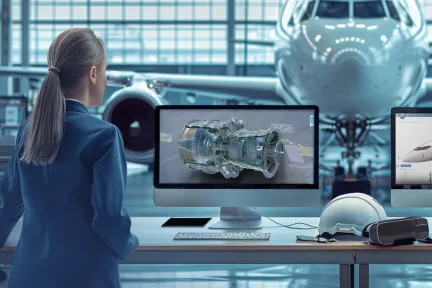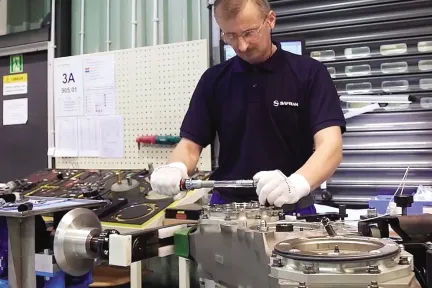Transforming the Supply Chain in the Value Network
Drive integration to improve visibility, on-time delivery and first-time quality.
Leverage Digitalization
The smart path to supplier development and program success.
The aerospace industry is one of the most complex and demanding in the world. Supply chains in this sector are composed of multiple levels of aerospace companies, suppliers and manufacturers who must collaborate closely to ensure quality and on-time deliveries. The COVID-19 pandemic has intensified challenges, disrupting global supply chains and increasing pressure on aerospace companies to reassess their strategies and adopt new technologies to remain competitive, reduce lead times and limit cost pressures.
Increasing Pressure on Suppliers
Today, supplier-created parts and content represent 50 to 60% of the value of an aerospace system. Air traffic is still expected to double over the next 20 years, adding this to relentless cost pressures Original Equipment Manufacturers (OEMs) and tier 1 suppliers have to reinvent the way they work with the supply chain. The new model requires a closer partnership to improve visibility and first-time quality, and reduce lead times.
To do so, all suppliers need to transform how they interact, providing higher visibility to OEMs to get tighter and seamless integration. From siloed and linear ecosystem, the supply chain needs to become a value network that ensures full access to any required knowledge, know-how, skills and talents as well as real-time social collaboration between individuals, groups or organizations.
Aircraft manufacturers who can’t find strong suppliers may seek to acquire and “insource” high value suppliers. The entire supply chain is undergoing a shift to effectively compete in the aerospace market.
Discover How Dassault Systèmes Transforms the Supply Chain
Developments over the next five to ten years will necessitate a massive shift in the aerospace supply chain. There will need to be the sourcing of alternative suppliers for new sustainable technologies, and that means the supply chain will have to be completely reshuffled.
Improving OEM and Supplier Collaboration
Manufacturers, like Boeing, Airbus, Dassault Aviation, Turkish Aerospace Industries, and other leading OEMs, are now leveraging new software platforms to work collaboratively with suppliers to design new platforms, update existing aircraft programs, modernize production systems and deploy new services. This transformation effort significantly improves the agility of the entire supply chain, improves first-time quality and significantly lowers costs.
The 3DEXPERIENCE® platform connects the dots between OEMs and suppliers to improve their collaboration. This results in improved visibility, on-time delivery and first time quality. Suppliers can interact seamlessly with OEMs to design components, integrate systems and continuously keep manufacturing activities in sync to avoid potential slowdowns within production.
Transform the entire supply chain to optimize operations:
Connect across organizations, functions, and companies worldwide by using a single System Digital Mockup (S-DMU) to drive down development costs by as much as 60%.
Increase profitability by creating and comparing multiple scenarios quickly and accurately to find the most profitable outcome.
Reduce lead times for parts supply through shared development of strategic plans, inventory targets and resource plans.
Avoid potential manufacturing issues through real-time alerts of plant disruptions, bottlenecks and the root cause of production delays across the entire supply chain.
The Future of the Supply Chain in the Value Network
The future of the aerospace supply chain lies in the adoption of advanced digital technologies such as artificial intelligence, the Internet of Things (IoT), and digital twins to enhance visibility, collaboration, and efficiency. Companies will also need to focus on resilience in response to geopolitical and economic disruptions while adopting sustainable strategies to meet growing customer and regulatory expectations.
Supply Chain in Aviation (FAQ)
The aerospace supply chain encompasses all processes and entities involved in the production, assembly, and delivery of aircraft and aerospace systems. This includes raw material suppliers, component manufacturers, OEMs, and logistics providers.
Supply chain disruptions in aerospace can result from various factors, including geopolitical tensions, economic downturns, natural disasters, and pandemics like COVID-19. These disruptions can lead to delays, increased costs, and challenges in maintaining quality and delivery schedules.
The biggest problem in the supply chain is often the lack of visibility and coordination among different stakeholders. This can lead to inefficiencies, delays, and increased costs. Additionally, external factors like geopolitical issues, economic volatility, and disruptions such as pandemics can exacerbate these challenges.
The aerospace industry is expected to see a gradual recovery in air travel demand post-pandemic, with a long-term growth trajectory driven by increasing global connectivity and technological advancements. However, the industry must navigate challenges like supply chain disruptions, cost pressures, and evolving regulatory requirements.
The aerospace supply chain consists of several tiers:
- OEM (Tier 0): Final product manufacturers (aerospace companies such as Boeing, Airbus).
- Tier 1: System integrators supplying major assemblies (e.g., engines, avionics).
- Tier 2: Suppliers of specific components and subsystems.
- Tier 3 & 4: Suppliers of raw materials, basic parts, and components.
Each tier reflects a level of specialization, with rigorous quality and compliance standards.
Explore Our Industry Solution Experiences
Learn how to drive integration to improve visibility, on-time delivery and first-time quality:




